Source Identification and Characterization of Indoor Particulate Matter in Potala Palace Museum
Abstract
1. Introduction
2. Materials and Methods
2.1. Site Description
2.2. Sampling
2.3. Chemical Composition Analysis
2.4. Statistical Analysis
3. Results
3.1. Concentration of Suspended Particulates
3.2. Chemical Composition Characteristics of Sedimentary Particulate Matter
4. Discussion
4.1. Particulate Matter Source Comprehensive Analysis
4.2. Influence of Temperature and Humidity on Particulate Matter
5. Conclusions
Author Contributions
Funding
Institutional Review Board Statement
Informed Consent Statement
Data Availability Statement
Conflicts of Interest
References
- Grau-Bové, J.; Mazzei, L. Corrigendum to “Simulation of particulate matter ingress, dispersion and deposition in a historical building” [J. Cult. Herit. 18 (2016) 199–208]. J. Cult. Herit. 2017, 24, e1. [Google Scholar] [CrossRef]
- Gawade, D.R.; Ziemann, S. A Smart Archive Box for Museum Artifact Monitoring Using Battery-Less Temperature and Humidity Sensing. Sensors 2021, 21, 4903. [Google Scholar] [CrossRef] [PubMed]
- Zhang, H.; Chen, J. Anthropogenic mercury enrichment factors and contributions in soils of Guangdong Province, South China. J. Geochem. Explor. 2014, 144, 312–319. [Google Scholar] [CrossRef]
- Zhang, Z.Y.; Jia, W.X. Hydrochemical Characteristics and Ion Sources of Precipitation in the Upper Reaches of the Shiyang River, China. Water 2020, 12, 1442. [Google Scholar] [CrossRef]
- Daher, N.; Ruprecht, A. Chemical Characterization and Source Apportionment of Fine and Coarse Particulate Matter Inside the Refectory of Santa Maria Delle Grazie Church, Home of Leonardo Da Vinci’s “Last Supper”. Environ. Sci. Technol. 2011, 45, 10344–10353. [Google Scholar] [CrossRef]
- Liang, C.; Wu, H. Efficient data preprocessing, episode classification, and source apportionment of particle number concentrations. Sci. Total Environ. 2020, 744, 140923. [Google Scholar] [CrossRef]
- Cuccia, E.; Massabo, D. Size-resolved comprehensive characterization of airborne particulate matter. Atmos. Environ. 2013, 67, 14–26. [Google Scholar] [CrossRef]
- Masková, L.; Smolík, J. Contribution of Visitors to the Indoor PM in the National Library in Prague, Czech Republic. Aerosol Air Qual. Res. 2016, 16, 1713–1721. [Google Scholar] [CrossRef]
- Wang, L.; Xiu, G. Characterizing Particulate Pollutants in an Enclosed Museum in Shanghai, China. Aerosol Air Qual. Res. 2015, 15, 319–328. [Google Scholar] [CrossRef]
- De Bock, L.A. Microanalysis of museum aerosols to elucidate the soiling of paintings: Case of the Correr Museum, Venice, Italy. Environ. Sci. Technol. 1996, 30, 3341–3350. [Google Scholar] [CrossRef]
- Gysels, K.; Deutsch, F. Characterisation of particulate matter in the Royal Museum of Fine Arts, Antwerp, Belgium. Atmos. Environ. 2002, 36, 4103–4113. [Google Scholar] [CrossRef]
- Hu, T.; Lee, S. Characterization of winter airborne particles at Emperor Qin’s Terra-cotta Museum, China. Sci. Total Environ. 2009, 407, 5319–5327. [Google Scholar] [CrossRef]
- Krupińska, B.; Worobiec, A. Assessment of the air quality (NO2, SO2, O3 and particulate matter) in the Plantin-Moretus Museum/Print Room in Antwerp, Belgium, in different seasons of the year. Microchem. J. 2012, 102, 49–53. [Google Scholar] [CrossRef]
- Cong, Z.; Kang, S. Elemental composition of aerosol in the Nam Co region, Tibetan Plateau, during summer monsoon season. Atmos. Environ. 2007, 41, 1180–1187. [Google Scholar] [CrossRef]
- Li, H.; Wang, Y. Research on the Application of Intelligent Monitoring Technology for Collection of Cultural Relics Based on the Internet of Things. In Proceedings of the 2017 7th International Conference on Mechatronics, Computer and Education Informationization (MCEI 2017), Shenyang, China, 3–5 November 2017. [Google Scholar]
- Cong, Z.; Kang, S. Trace elements and lead isotopic composition of PM10 in Lhasa, Tibet. Atmos. Environ. 2011, 45, 6210–6215. [Google Scholar] [CrossRef]
- Jetter, J.J.; Guo, Z.S. Characterization of emissions from burning incense. Sci. Total Environ. 2002, 295, 51–67. [Google Scholar] [CrossRef]
- Camuffo, D.; Brimblecombe, P. Indoor air quality at the Correr Museum, Venice, Italy. Sci. Total Environ. 1999, 236, 135–152. [Google Scholar] [CrossRef]
- Camuffo, D.; Van Grieken, R. Environmental monitoring in four European museums. Atmos. Environ. 2001, 35, S127–S140. [Google Scholar] [CrossRef]
- Gao, Y.; Chen, F. The distribution and influential factors of PM2.5 and CO2 in urban rail carriages. Indoor Built Environ. 2019, 28, 1383–1395. [Google Scholar] [CrossRef]
- Worobiec, A.; Samek, L. A seasonal study of atmospheric conditions influenced by the intensive tourist flow in the Royal Museum of Wawel Castle in Cracow, Poland. Microchem. J. 2008, 90, 99–106. [Google Scholar] [CrossRef]
- Miller, J.D.; Kelly, A. Changes in rainfall chemistry and airborne particulates during a period of major local industrial change. Sci. Total Environ. 2000, 262, 137–145. [Google Scholar] [CrossRef] [PubMed]
- Turner, A.; Sogo, Y. Concentrations and bioaccessibilities of metals in exterior urban paints. Chemosphere 2012, 86, 614–618. [Google Scholar] [CrossRef] [PubMed]
- Rasmussen, P.E.; Subramanian, K.S. A multi-element profile of housedust in relation to exterior dust and soils in the city of Ottawa, Canada. Sci. Total Environ. 2001, 267, 125–140. [Google Scholar] [CrossRef] [PubMed]
- Harrison, R.M.; Tilling, R. A study of trace metals and polycyclic aromatic hydrocarbons in the roadside environment. Atmos. Environ. 2003, 37, 2391–2402. [Google Scholar] [CrossRef]
- Zou, J.Y.; Liu, Z. Sources and distribution of heavy metal and C-N isotopes in topsoils across an urban-rural gradient in a typical hazy city, northern China. Atmos. Environ. 2020, 241, 117802. [Google Scholar] [CrossRef]
- Pan, H.Y.; Lu, X.W. A comprehensive analysis of heavy metals in urban road dust of Xi’an, China: Contamination, source apportionment and spatial distribution. Sci. Total Environ. 2017, 609, 1361–1369. [Google Scholar] [CrossRef] [PubMed]
- Jahanbin, A.; Semprini, G. Integrated effects of the heat recovery ventilation and heat source on decay rate of indoor airborne particles: A comparative study. J. Build. Eng. 2022, 50, 104156. [Google Scholar] [CrossRef]
- Han, Y.; Hu, Y. Effects of air temperature and humidity on particle deposition. Chem. Eng. Res. Des. 2011, 89, 2063–2069. [Google Scholar] [CrossRef]
- Kim, J.J.; Hann, T. Effect of flow and humidity on indoor deposition of particulate matter. Environ. Pollut. 2019, 255, 113263. [Google Scholar] [CrossRef]
- Lucchi, E. Review of preventive conservation in museum buildings. J. Cult. Herit. 2018, 29, 180–193. [Google Scholar] [CrossRef]
- Luciani, A. Historical Climates and Conservation Environments. Historical Perspectives on Climate Control Strategies within Museums and Heritage Buildings. Ph.D. Thesis, Politecnico di Milano, Milan, Italy, 2013. [Google Scholar]
- van Schijndel, A.W.M.; Schellen, H.L. Application of an integrated indoor climate, HVAC and showcase model for the indoor climate performance of a museum. Energy Build. 2008, 40, 647–653. [Google Scholar] [CrossRef]
- Ferdyn-Grygierek, J. Indoor environment quality in the museum building and its effect on heating and cooling demand. Energy Build. 2014, 85, 32–44. [Google Scholar] [CrossRef]
- Mueller, H.F.O. Energy efficient museum buildings. Renew. Energy 2013, 49, 232–236. [Google Scholar] [CrossRef]
- Papadopoulos, A.M.; Avgelis, A. Energy study of a medieval tower, restored as a museum. Energy Build. 2003, 35, 951–961. [Google Scholar] [CrossRef]

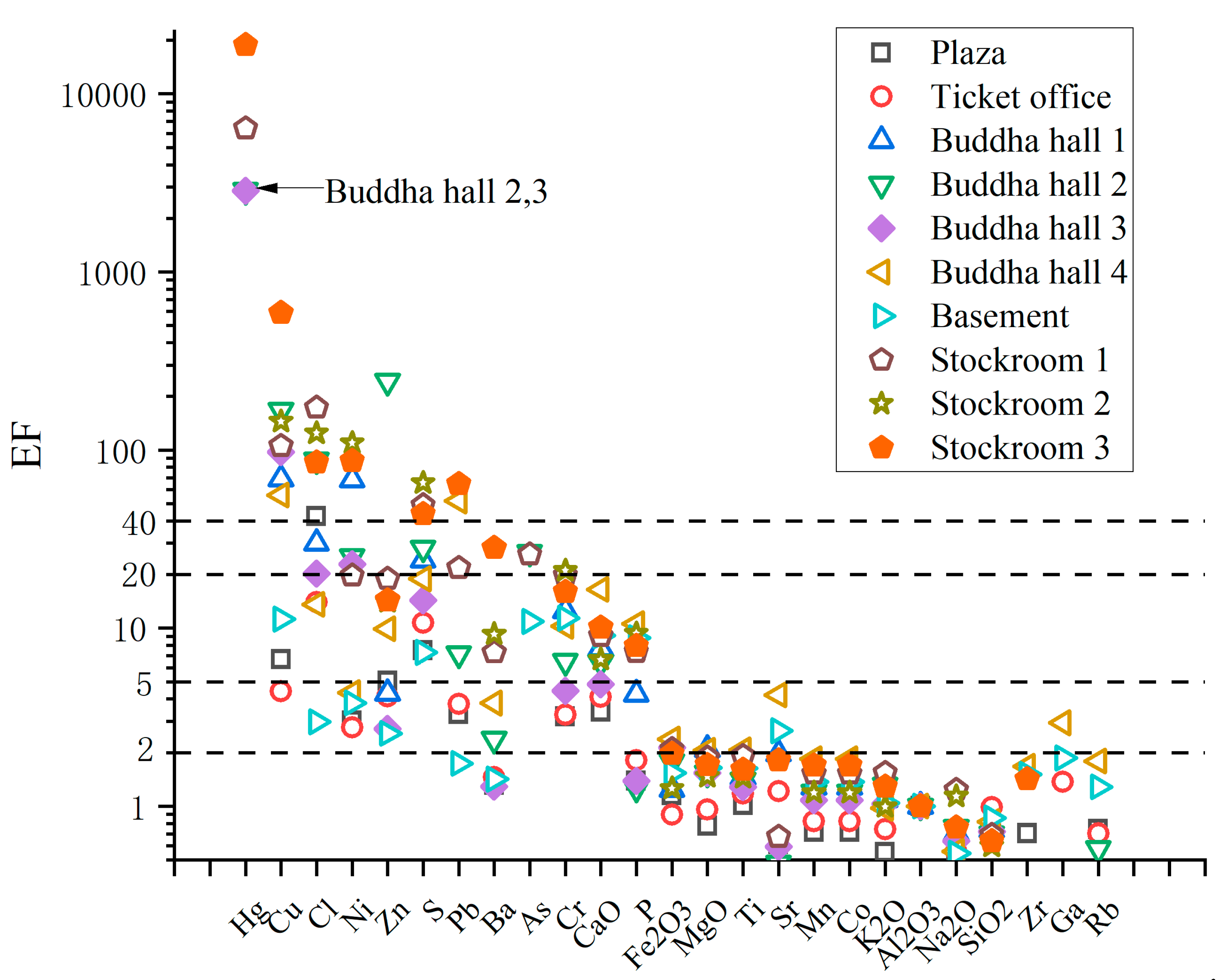
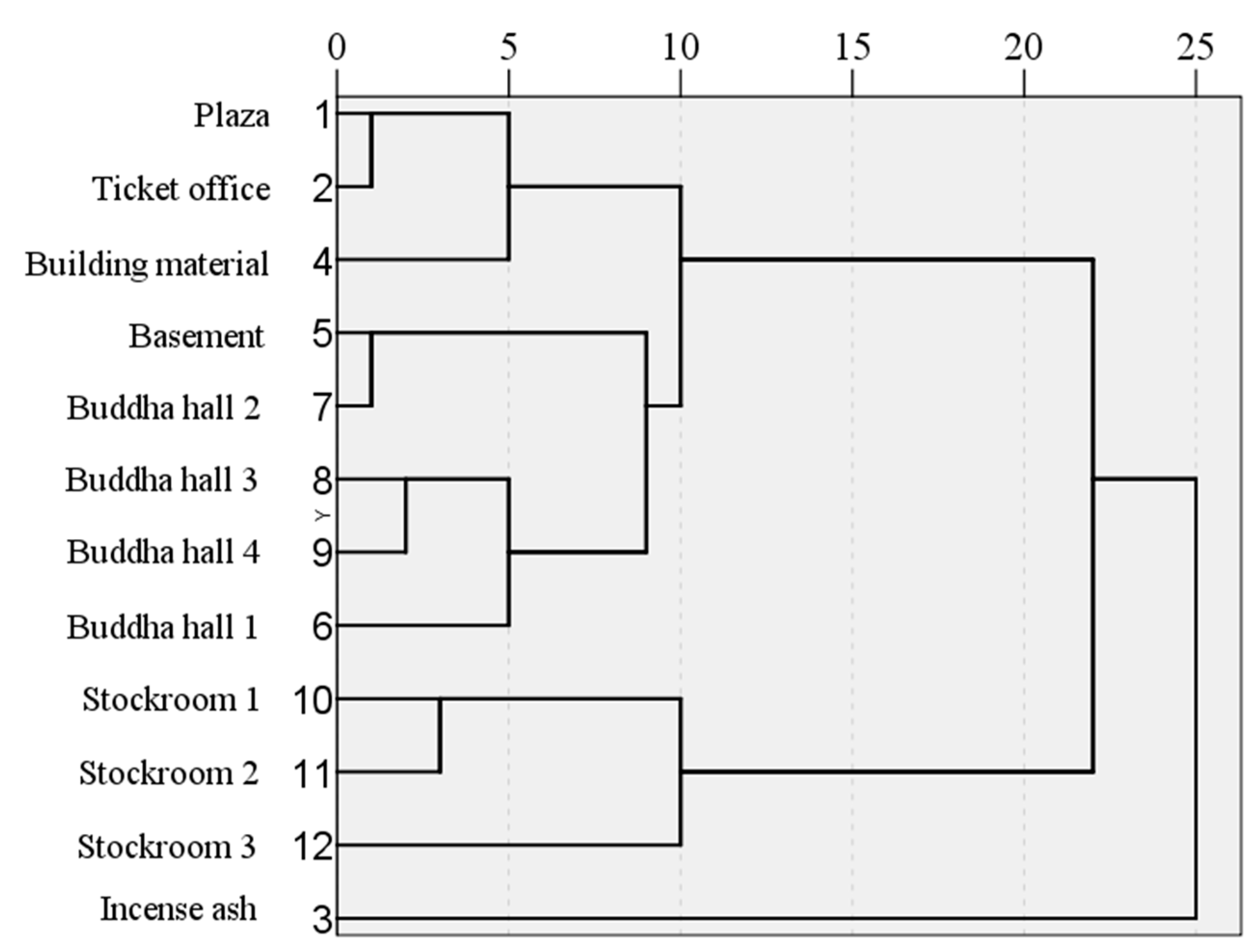
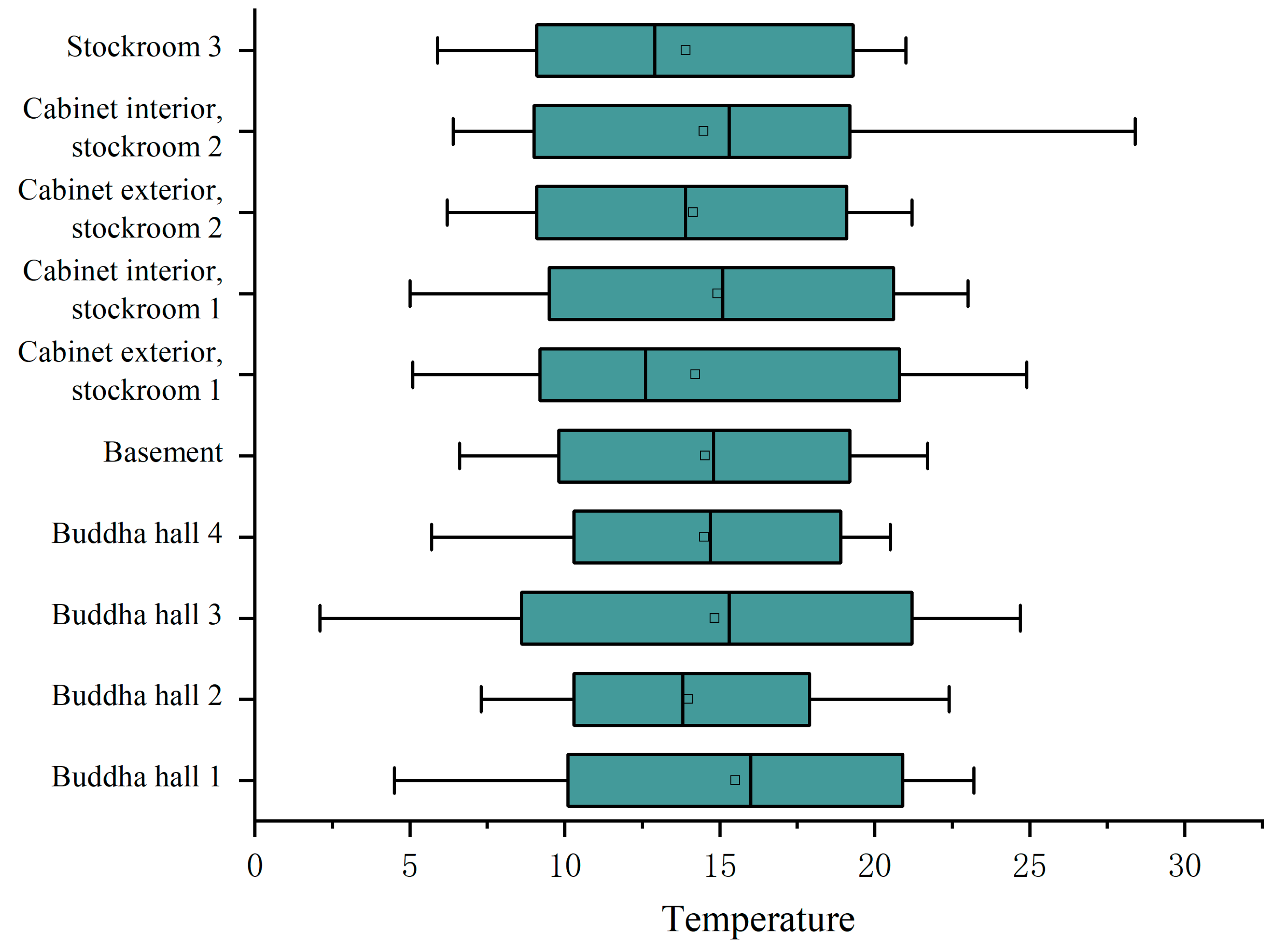
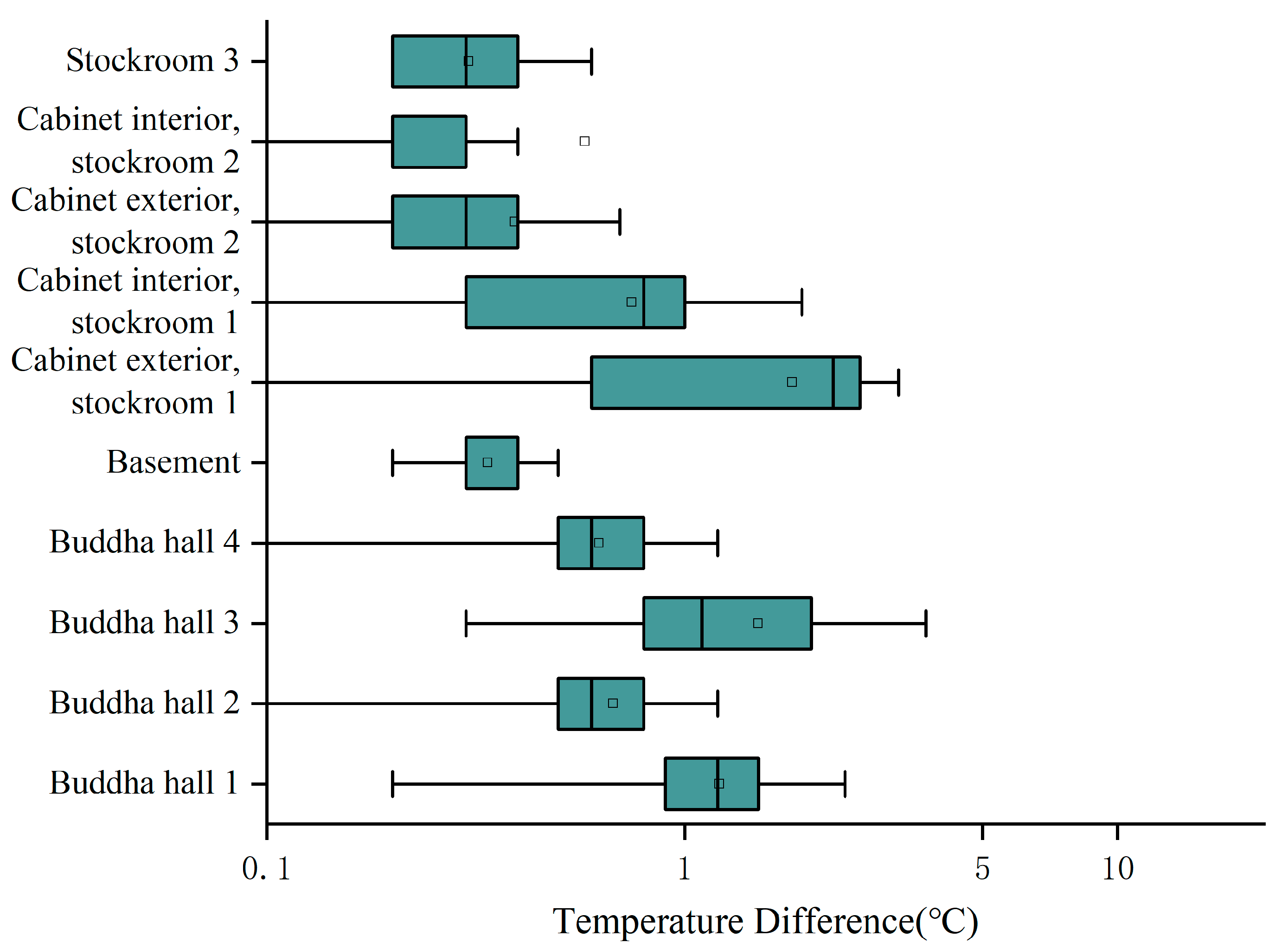
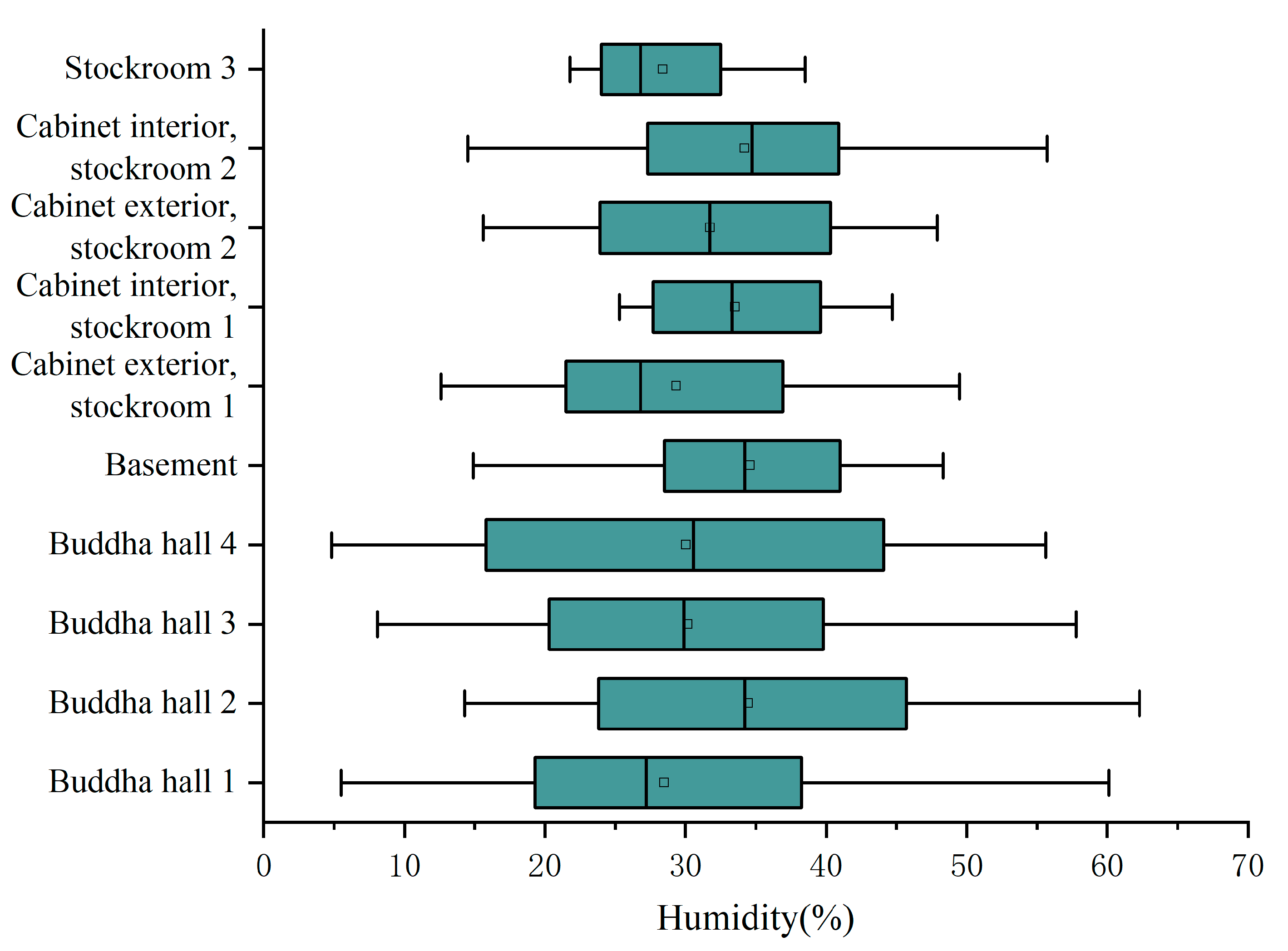
| Sampling Rooms | Area (m2) | Description |
|---|---|---|
| Basement | 47 | A small, windowless room typically kept closed. |
| Stockroom 1 | 109 | A room with openable windows and occasional staff repairing scriptures. |
| Stockroom 2 | 36.5 | A windowless room that is regularly cleaned and relatively tidy. |
| Stockroom 3 | 164 | A room with closed windows and occasional staff activities. |
| Buddha hall 1 | 102 | A room with windows, tourists, and burning incense sticks and butter lamps. |
| Buddha hall 2 | 120 | |
| Buddha hall 3 | 270 | A windowless room with tourists and burning incense sticks and butter lamps. |
| Buddha hall 4 | 445 |
| Distribution of Particle Size | <0.5 μm | 0.5–1 μm | 1–2.5 μm | 2.5–5 μm | 5–10 μm | PM2.5 | PM10 |
|---|---|---|---|---|---|---|---|
| Outdoor | 0.5 ± 0.5 | 0.8 ± 0.4 | 2.5 ± 0.7 | 5.1 ± 1 | 21.9 ± 4.5 | 3.8 | 30.8 |
| Basement | 1 ± 0 | 2 ± 0 | 20 ± 3.2 | 70.3 ± 9.5 | 340.1 ± 43 | 23 | 433.4 |
| Stockroom 1 | 0.9 ± 0.3 | 1.9 ± 0.4 | 20.3 ± 2.6 | 76.6 ± 10.8 | 333.5 ± 58.9 | 23.1 | 433.2 |
| Stockroom 2 | 0.9 ± 0.3 | 0.9 ± 0.3 | 4 ± 0.9 | 11 ± 3.3 | 48.1 ± 16.6 | 5.8 | 64.9 |
| Stockroom 3 | 0 ± 0 | 0.7 ± 0.5 | 9.1 ± 3.2 | 45.5 ± 16 | 244.6 ± 80.4 | 9.8 | 299.9 |
| Buddha Hall 1 | 1.8 ± 0.9 | 2.2 ± 0.9 | 6.8 ± 2.3 | 8.9 ± 2 | 39.5 ± 9.7 | 10.8 | 59.3 |
| Buddha Hall 2 | 1.3 ± 0.7 | 1.6 ± 0.9 | 6.3 ± 2.3 | 11.1 ± 5.5 | 49.1 ± 32.8 | 9.2 | 69.4 |
| Buddha Hall 3 | 30.7 ± 5.1 | 46.2 ± 17.9 | 86.8 ± 51.2 | 17.8 ± 6.8 | 50.7 ± 10.7 | 163.7 | 232.3 |
| Buddha Hall 4 | 25.1 ± 14.4 | 48.4 ± 32.9 | 98.8 ± 63.5 | 42 ± 24 | 163.5 ± 163.1 | 172.3 | 377.8 |
| Topsoil | Plaza | Ticket Office | Incense Sticks | Construction Site | Buddha Hall 1 | Buddha Hall 2 | Buddha Hall 3 | Buddha Hall 4 | Basement | Stockroom 1 | Stockroom 2 | Stockroom 3 | |
|---|---|---|---|---|---|---|---|---|---|---|---|---|---|
| SiO2 a | 65.74 | 59.4 | 66.4 | 20.2 | 75.4 | 50.8 | 47.8 | 53.1 | 44.0 | 54.3 | 43.1 | 43.9 | 40.9 |
| CaO a | 2.1 | 9.2 | 8.8 | 32.6 | 2.0 | 16.8 | 14.1 | 11.4 | 28.4 | 18.4 | 18 | 15.7 | 20.6 |
| K2O a | 31 | 2.1 | 2.3 | 13.9 | 4.5 | 3.4 | 4.1 | 3.5 | 2.4 | 3 | 4.4 | 3.3 | 3.8 |
| MgO a | 1.19 | 1.2 | 1.2 | 8.0 | 0.9 | 2.6 | 1.9 | 2 | 2.0 | 1.9 | 2.1 | 2 | 2 |
| Fe2O3 a | 3.92 | 5.8 | 3.6 | 4.9 | 2.5 | 5.1 | 7.3 | 9.3 | 7.7 | 5.8 | 7.8 | 5.5 | 7.5 |
| Al2O3 a | 13.89 | 17.9 | 14.2 | 5.8 | 11.9 | 14.5 | 14.5 | 15.5 | 11.4 | 13.4 | 13.2 | 15.5 | 13.5 |
| Na2O a | 2.14 | 1.5 | 1.2 | 1.9 | 2.1 | 1.6 | 1.7 | 1.5 | 1.0 | 1.1 | 2.5 | 2.7 | 1.6 |
| Cl | 149 | 8152.0 | 2133.0 | 12,991.0 | 126.0 | 4666.0 | 13,681 | 3379 | 1659.0 | 427 | 24,439 | 20,742 | 12,380 |
| S | 255 | 2467.6 | 2800.9 | 19,638.9 | 122.6 | 6419.2 | 7494.6 | 4081.3 | 3952.0 | 1792.7 | 11,848.3 | 18,659.2 | 10,871.8 |
| P | 764 | 1372.0 | 1418.0 | 20,421.0 | 487.0 | 6643.0 | 6499 | 3411 | 1008.0 | 1184 | 5345 | 7962 | 5907 |
| Ti | 3320 | 4342.3 | 4009.0 | 2908.0 | 2278.7 | 5058.5 | 4862.5 | 4757 | 5633.9 | 5230.5 | 6027.7 | 5383.4 | 5195.2 |
| Ba | 436 | 741.6 | 650.2 | 3381.1 | 231.1 | 0.0 | 1081 | 628.7 | 1356.0 | 596.5 | 3019.2 | 4510.5 | 11,961.4 |
| Sr | 177 | 139.5 | 220.7 | 2443.8 | 275.7 | 364.4 | 88.8 | 117.5 | 612.2 | 452.4 | 113.3 | 0 | 312 |
| Rb | 147 | 57.6 | 106.1 | 353.0 | 220.4 | 0.0 | 88.7 | 64.9 | 215.8 | 182 | 0 | 0 | 0 |
| Zr | 266 | 174.7 | 389.4 | 219.1 | 129.6 | 0.0 | 0 | 91.8 | 364.2 | 386.4 | 0 | 0 | 367.2 |
| Hg | 0 | 0.0 | 0.0 | 0.0 | 0.0 | 0.0 | 276 | 293.6 | 0.0 | 0 | 560.3 | 0 | 1683.7 |
| Ga | 17 | 0.0 | 23.8 | 0.0 | 16.4 | 0.0 | 0 | 0 | 40.9 | 30.5 | 0 | 0 | 0 |
| Mn | 619 | 571.5 | 521.2 | 1831.6 | 353.2 | 827.9 | 773.7 | 750.4 | 936.3 | 818.6 | 896.8 | 824 | 1020.7 |
| Zn | 65 | 425.0 | 274.8 | 509.4 | 43.4 | 292.4 | 16476.4 | 197.6 | 528.6 | 160.7 | 1166.6 | 1024.4 | 907.1 |
| Cr | 42 | 173.1 | 140.3 | 149.8 | 144.4 | 550.1 | 285.3 | 209.4 | 353.1 | 459.8 | 789.6 | 989.4 | 654.1 |
| Cu | 22 | 189.3 | 99.9 | 167.0 | 37.5 | 1581.0 | 3829 | 2393.4 | 1006.6 | 238.1 | 2207.3 | 3561.4 | 12594.2 |
| Ni | 21 | 81.7 | 59.7 | 75.4 | 40.9 | 1492.2 | 554 | 535.9 | 74.6 | 77 | 393.7 | 2573.4 | 1778.2 |
| Pb | 31 | 131.8 | 118.8 | 0.0 | 0.0 | 0.0 | 232.1 | 0 | 1313.6 | 52 | 642.4 | 0 | 1947.6 |
| As | 20 | 0.0 | 0.0 | 0.0 | 0.0 | 0.0 | 0 | 0 | 0.0 | 209.8 | 0 | 0 | 0 |
| Co | 10 | 129.3 | 0.0 | 0.0 | 0.0 | 0.0 | 278.6 | 0 | 0.0 | 0 | 245.9 | 0 | 0 |
| Measuring Range | Accuracy | Resolution Ratio | Physical Drawing | ||
|---|---|---|---|---|---|
| Temperature/°C | −20~70 | ±0.3 | 0.01 |  | |
| Relative humidity/% | 0~100 | ±2 | 0.05 |  | |
| Concentration of CO2/ppm | 0~2000 | ±50 | 1 |  |  |
| Illumination intensity/Lux | 0~10,000 | ±4% | 0.06 |  |  |
| Ultraviolet intensity μw/cm2 | 0.02~230 | ±8% | 0.01 |  |  |
Disclaimer/Publisher’s Note: The statements, opinions and data contained in all publications are solely those of the individual author(s) and contributor(s) and not of MDPI and/or the editor(s). MDPI and/or the editor(s) disclaim responsibility for any injury to people or property resulting from any ideas, methods, instructions or products referred to in the content. |
© 2023 by the authors. Licensee MDPI, Basel, Switzerland. This article is an open access article distributed under the terms and conditions of the Creative Commons Attribution (CC BY) license (https://creativecommons.org/licenses/by/4.0/).
Share and Cite
Zhang, G.; Li, W.; Cheng, Q.; Zhou, Z.; Wang, Q.; Peng, Z. Source Identification and Characterization of Indoor Particulate Matter in Potala Palace Museum. Buildings 2023, 13, 2138. https://doi.org/10.3390/buildings13092138
Zhang G, Li W, Cheng Q, Zhou Z, Wang Q, Peng Z. Source Identification and Characterization of Indoor Particulate Matter in Potala Palace Museum. Buildings. 2023; 13(9):2138. https://doi.org/10.3390/buildings13092138
Chicago/Turabian StyleZhang, Ge, Wenqing Li, Qian Cheng, Zhipeng Zhou, Qiaochu Wang, and Zhiyuan Peng. 2023. "Source Identification and Characterization of Indoor Particulate Matter in Potala Palace Museum" Buildings 13, no. 9: 2138. https://doi.org/10.3390/buildings13092138
APA StyleZhang, G., Li, W., Cheng, Q., Zhou, Z., Wang, Q., & Peng, Z. (2023). Source Identification and Characterization of Indoor Particulate Matter in Potala Palace Museum. Buildings, 13(9), 2138. https://doi.org/10.3390/buildings13092138







